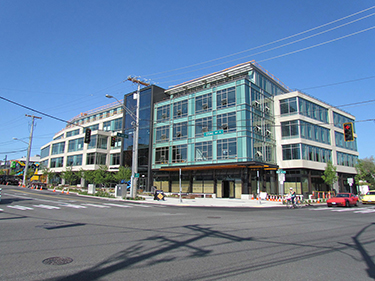|
Subscribe / Renew |
|
|
Contact Us |
|
| ► Subscribe to our Free Weekly Newsletter | |
| home | Welcome, sign in or click here to subscribe. | login |
Construction
| |
 |
April 30, 2015
Survey: McKinstry
Specialty: Mechanical and electrical contracting; energy and facility services
Management: Brian Antonsen, business unit manager, Western Washington construction; Michael Frank, director of engineering; Kristina Sing, engineering manager
Founded: 1960
Headquarters: Seattle
2014 revenues: $573 million
Projected 2015 revenues: $575 million
Current projects: Mechanical, electrical and fire protection for Seattle Children’s Hospital 1915 Terry building; designed system that uses waste heat from the Westin Exchange Building data center to heat offices across the street; design-build mechanical and plumbing for Stone 34 office building in Seattle
Heidi de Laubenfels, McKinstry vice president, external relations and communications, answered written questions from the DJC about McKinstry and trends and issues in the industry.
Q: What’s the most exciting innovation you’ve recently come across?
A: We’re particularly excited about the district energy project in the Denny Triangle area of Seattle. Capturing waste heat for re-use isn’t new; in fact, McKinstry has a small version of the same system in our own data center. What is new is the cooperation between the energy supplier (the data center) and the user (the office building), which are different entities. Collaboration with the city of Seattle was also key in making this technical solution come to life.
McKinstry is working on several other energy recycling opportunities in Seattle. Dense, energy-intensive, mixed-use environments — such as cities — are fertile ground for recycling energy. We hope our district energy project catalyzes a shift in the way communities think about energy use and policy that shapes it.
Q: What hurdles does your industry face?
A: Despite recent efforts to move toward more integrated delivery approaches, the construction industry still remains siloed and inefficient. We believe that we can come together as an industry and do what’s in the best interest of our clients, which will ultimately serve all of us.
We also see tremendous opportunity in making our built environment itself more efficient. Currently, energy performance contracting work revolves around the public sector, but we see opportunities for growth in the private commercial sector.
Q: What trends are you seeing?
A: Many of our clients are faced with significant backlogs of deferred maintenance and declining budgets, and are looking for guaranteed outcomes like predictable project schedules, firm budgets and manageable costs for future operations and maintenance of increasingly complex buildings.
Thoughtful approaches to public-private partnership models are emerging. Project delivery methods that encourage integration and collaboration are gaining momentum, and new decision-making models that incorporate a total-cost-of-ownership mentality are providing an enhanced level of certainty for owners as they weigh investment decisions. We expect to see the market for efficiently designed, built, operated and optimized buildings continue to grow — through energy savings performance contracting, as well as design/build and other mechanisms.
Q: How has your company changed over the last five years?
A: Over the last five years, McKinstry’s geographic diversity has continued to grow. One-third of our revenue now comes from outside the Pacific Northwest. We also successfully integrated our Service, Energy Management, and Facility Management lines of business, building a reputation as one of the leading data-center facility managers in the country.
Our major project construction team continued to look for new and innovative approaches to drive waste out of the construction process. Over the past five years, it has proven the value of off-site fabrication and the feasibility of integrating trades to build more efficiently, and has made a strong case for increased collaboration across the industry.
Q: How does Seattle stack up to other markets?
A: Seattle has a lot going for it. It’s surrounded by an amazing natural landscape, its economy is booming, and good, living-wage jobs are plentiful. The area’s strong sense of environmental stewardship also drives progressive practices.
Seattle sports a local government that’s willing to try new things. For example, the city has one of the most stringent energy codes in the country, and it’s on track to meet the state goal of improving energy efficiency 70 percent by 2030.
Other examples include public energy disclosure by all commercial buildings over a certain size; Seattle City Light’s “Pay for Performance” pilot, where the utility pays out rebates for actual — rather than expected — energy saved; and the Deep Green Pilot Program, which helps bring high-performance buildings like Stone34 to market.
Other Stories:
- Industry associations now have 3 generations of members
- ABC Awards • Infrastructure
- ABC Awards • Mechanical Construction
- ABC Awards • Multifamily Construction
- ABC Awards • Specialty Contracting Interior
- ABC Awards • Tenant Improvement
- Survey: High Country Contractors & Developers
- Survey: Howard S. Wright
- Survey: Sellen Construction
- Survey: Schuchart
- Survey: GLY Construction
- ABC Awards • Industrial Construction
- ABC Awards • Historic Preservation
- ABC Awards • Health Care
- Contractors face new risks with early design
- How to keep safe while working in a deep hole
- In dispute resolution, trained ‘neutrals’ are a plus
- Is your deck designed to handle a crowd?
- What is high-performance teamwork? Local leaders tell all
- Why it’s better to rent than buy Tier 4 equipment
- Eagle of Excellence • Mixed-Use Construction
- ABC Awards • Commercial Construction
- ABC Awards • Community & Public Service
- ABC Awards • Electrical & Communications
- Survey: Alston Construction



